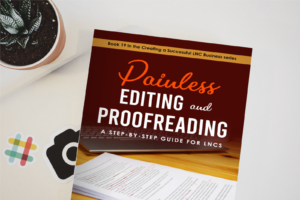The LNC Guide to Proofreading and Editing
The LNC Guide to Proofreading and Editing
Have you ever made a cringe-worthy typo? Embarrassing typos reflect your expertise. Knowing how to proofread your work product makes the difference between something that makes you ashamed and something that makes you proud.
Sound harsh? There are many typos in everyday signs, on the internet, and in ads – who cares? Many readers do; if you look at Amazon reviews, you’ll notice how often reviewers comment on grammatical, spelling, and punctuation errors.
That doesn’t mean you should wish for death if you spot a few typos in your completed work, but I do mean a few.
Techniques to Proofread Like a Pro
- Proofread when you are fresh. Is this when you first wake up? Right after dinner? So, do this work when you are most alert and able to focus.
- Don’t proofread until your vision gets blurred and commas look like semicolons. Whenever possible, walk away from the pages and look at them again the next day.
- Print it out. Some editors believe this is essential. some proofread better on a computer screen where they can increase the type size if necessary. See what works for you.
- Look at it in stages. For example, you might first read the body of the text for typos that spell check does not catch. You know those pesky ones, like int he, form versus from, and trial versus trail.
- That is my next point. You may habitually make the same mistakes. Therefore, look for the words you commonly misspell.
- After looking at the body of the text, look at the headers. Make sure you are consistently capitalizing the major words in your headers. If you use subheads, the first word of the subhead is capitalized.
- Look for consistency. One of the common errors I have seen is writers’ inconsistent writing of dates. Pick one method and stick with it. Either write out the month in letters or use numbers, but don’t use both systems in one document.
- Look for what I call idiosyncratic capitalization. I illustrated this is comparing the president of a corporation to President Biden.
- Consult online sources.

Painless Editing and Proofreading for LNCs: A Step by Step Guide gives you the support you need to produce flawless work for attorneys.
Painless Editing and Proofreading: A Step-by-Step Guide for LNCs
Do you want to enhance your writing skills and ensure the attorney’s comprehension of every word you produce? Do you want repeat business and new attorney clients? Look no further! Painless Editing and Proofreading is Pat Iyer’s ultimate guide that will transform your editing process and make you a master of written communication.
Order for instant download here.
How to Polish Your Writing: Editing Checklist
Use this as a starting point to develop your individualized checklist based on your patterns and needs as a writer.
Allow yourself to distance yourself and your writing before you begin editing.
Separate your editing tasks into phases. And separate it from yourself. Be detached – read it as if you saw it for the first time.
Phase 1
- Do you have a strong introduction that hooks the reader?
- Does the content logically flow?
- Do you use transitional phrases to carry the reader to the next point?
- Does the ending summarize your main points?
Phase 2
- Did you avoid including any sections where you repeat your ideas?
- Does each paragraph contain just one topic?
- Are big chunks of text broken up with subheadings and paragraph breaks?
- Is the formatting of your headers consistent?
- Is the justification of your text consistent (all left justified or fully justified)?
- Did you use data, statistics, or quotations to support your points?
Final Phase
- Do the sentences vary in length?
- Are your paragraphs short?
- Are all spelling, capitalization, and punctuation correct?
- Can you replace weak verbs and adjectives with stronger ones?
- Can you trim any long sentences and tighten your writing?
In Closing
If you are writing a report, you will have a due date for delivering it. Don’t push the work until the last minute. You’ll be far more able to find typos and errors if you can put some distance between yourself and the work so you can approach it with a fresh eye.
You will find editing and proofreading more challenging if you are in the early stages of writing expert reports, blog posts, or a book.
Practice makes for improvement and greater speed because you will:
- Enhance your familiarity with grammatical rules
- Next, develop a designer’s eye when it comes to seeing that your text needs some white space
- Gain the ability to write with ease, and
- Learn how to organize your thoughts logically and sequentially.
Plan. Schedule. Be kind to yourself and the person who needs your work product.

Pat Iyer is president of The Pat Iyer Group, which develops resources to assist LNCs in obtaining more clients, making more money, and achieving their business goals and dreams.
Pat’s related websites include the continuing education provided on LNCEU.com, the podcasts broadcast at podcast.legalnursebusiness.com, and writing tips supplied at patiyer.com.
Get all of Pat’s content in one place by downloading the mobile app, Expert Edu at www.legalnursebusiness.com/expertedu. Watch videos, listen to podcasts, read blogs, watch online courses and training, and more.

